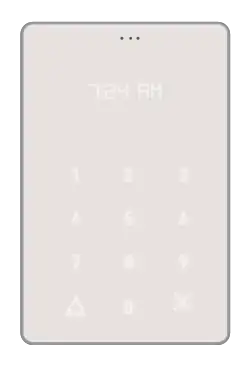Light Phone (1st generation)
 First-generation Light Phone (2017) | |
| Developer | Light |
|---|---|
| Manufacturer | Light |
| Product family | Light Phone |
| Type | Mobile phone |
| Release date | May 2017 |
| Introductory price | US$150 at launch |
| Operating system | LightOS (custom firmware) |
| CPU | NXP chipset (proprietary) |
| Memory | Unknown |
| Storage | ~512 MB |
| Display | OLED numeric display (non-touch) |
| Input | T9-style keypad, power button, USB button |
| Connectivity | 2G GSM |
| Power | Non-removable battery (600–800 mAh est.) |
| Dimensions | 85.6 mm × 53.98 mm × 4.0 mm (credit card sized) |
| Weight | ~38 grams |
| Predecessor | None |
| Successor | Light Phone II |
| Website | Light Phone – Official Site |
The Light Phone is a 2G minimalist mobile phone developed by Light. It was introduced in 2015 as an “anti-smartphone,” designed to be “used as little as possible,” with the goal of helping users disconnect from the constant notifications, social media, and apps that characterize modern smartphones.[1]
It can make and receive phone calls, and was designed primarily to function as a companion phone, working through call forwarding from a user's primary device. Unlike later models, the original Light Phone does not support texting, internet access, or third-party applications, and has no camera or GPS capability.
Subsequent versions include the Light Phone II and the Light Phone III.
Design and features
The Light Phone features an ultra-minimalist, credit-card-sized form factor. It has a small white LED display and T9-style keypad. The casing is sleek and white, with no camera, no internet connectivity, and no apps.[2]
Designed as a companion device to a smartphone, it could forward calls via a companion app. Users could insert a SIM card and use the Light Phone independently for calls only, with 500-number contact storage and 3 days of standby battery life.[3]
Technical specifications
- Display: LED matrix (white)
- Network: 2G GSM (850/1900)
- Input: T9 numeric keypad
- Battery life: Up to 3 days standby, 3 hours talk time
- Weight: 38.5 grams
- Storage: Stores up to 500 contacts
- Charging: Micro-USB
- Dimensions: 85.6 mm × 53.98 mm × 4 mm
Reception
Reception to the Light Phone was generally positive among digital minimalists and critics of modern smartphone overuse. MIT Technology Review called it a “genuinely radical” device aimed at helping people reclaim their attention.[4] However, mainstream reviewers noted limitations due to the lack of texting, 4G support, or a usable screen.[5]
Legacy
The Light Phone was followed by two successor devices: the Light Phone II, which added a monochrome E Ink touchscreen and support for texting and additional "tools",[6] and the Light Phone III, which further introduced a monochrome AMOLED screen, camera, and 5G connectivity.
The original Light Phone is now considered a seminal example of the minimalist tech movement, often cited in discussions of digital minimalism and smartphone overuse.
See also
References
- ^ "Can This Dumb Phone Free Us from Smartphone Addiction?". MIT Technology Review. March 31, 2017.
- ^ "The Light Phone: minimalist phone designed to be used as little as possible". Dezeen. May 6, 2017.
- ^ "Light Phone review: Dumb phone, smart idea". GWW. 2017.
- ^ "Can This Dumb Phone Free Us from Smartphone Addiction?". MIT Technology Review.
- ^ "Light Phone: Cell Phone Minimalism Taken to the Extreme". Financial Times. April 2017.
- ^ "Light Phone 2 is a distraction-free phone with a minimalist look". Pocket-lint. 2018. Retrieved July 18, 2025.